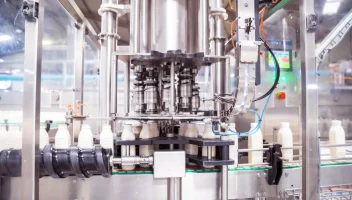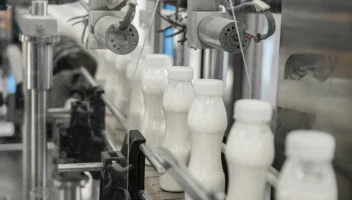Confronting 5 Major Challenges with ERP for the Dairy Industry
Confronting 5 Major Challenges with ERP for the Dairy Industry
Confronting 5 Major Challenges with ERP for the Dairy Industry
22 Sept 2021
Jack Payne
The dairy industry stands apart from other food and beverage segments with its numerous unique challenges. Such kitchen staples as milk, cheese and butter might seem simple and plain to consumers, but the truth behind these products is that the associated manufacturing processes and critical considerations of the businesses that make them are actually quite complex.
As a professional in the sector, you know that your organization’s operations are built on exacting science and nuanced procedures. Running a dairy well—remaining fully compliant with safety standards, satisfying customers with excellent offerings and maintaining organized financials with a solid bottom line—is tough work, to say the least.
In reality, tackling your toughest concerns takes more than know-how. You’re best served by looking to technology to assist in overcoming several of the most daunting challenges.
Here we’ll highlight five of those challenges, as well as how enterprise resource planning (ERP) solutions for the dairy industry can equip your company with the tools necessary to master them.
Challenge 1: Assessing Component Breakdown Accurately and Quickly
Analyzing the raw milk you receive at your facilities requires precision. You need to know the percentages of butterfat, protein, solids, non-fact and other components in each batch in order to optimize the use of your materials. Leaving this task to individual team members is not the best approach, as the process is time-consuming and humans are prone to error.
This step is also vital for properly classing your milk. Because you must apply a class as soon as you receive the shipment and create the appropriate records in your interface, most dairies choose to place everything in the lowest class and go back later to properly account for components. That can be a less-than-ideal situation, considering accuracy on this front is crucial for compliance.
Solution
ERP systems designed for dairy businesses like yours facilitate and streamline the assessment of received raw milk by integrating with your smart devices dedicated to the procedure. This allows for automated data capture and real-time updates on the platform, giving you complete visibility and confidence in the figures gathered.
Additionally, the “class adder” functions of purpose-built solutions allow you to cleanly revise the classes of your milk once you’ve determined their breakdown and purpose. With that, you’ll be able to satisfy regulations and have a complete idea of exactly what you have on-hand.
Challenge 2: Getting the Most Out of Materials With Varying Expiration Dates
Each new shipment of milk comes with a window of freshness and expiration date. If you don’t make sure to accurately record this information and associate it with the products you derive from that batch, you risk wasting what you’ve already purchased by not using it in time. Or, in an even worse scenario, delivering spoiled products to clients.
This is compounded by the fact that the various processes through which cheese, butter, cream and other non-milk dairy goods go can have an effect on their ranges of viability. Typically, these items have a longer shelf-life than liquid milk, but it’s still crucial to account for the change and apply all necessary freshness and expiration labels.
Solution
The inventory management features of ERP solutions can automatically log expiration dates and maintain that information as it becomes associated with products made from a given lot of raw milk. This also helps maintain total traceability, as once the date is tied to a given item, it will remain so all along the supply chain.
What’s more, advanced solutions like Aptean's dairy ERP are also built with best practices in mind, including first-expiry, first-out (FEFO) protocols that help to ensure materials don’t go bad before they can be used. This both keeps your margins healthy and contributes to more sustainable operations.
Challenge 3: Maintaining Quality With a Wide Variety of End Products
From your standard gallon of whole milk to top-of-the-line premium cheeses, dairies put out quite a range of offerings. Your consumers expect different characteristics in each, but when the criteria for what makes a good product is different from one item to the next, knowing what’s most important for the case at hand and making sure that necessary checks are performed can become complicated.
Consistency, color, texture and even shape—all can be used by customers to evaluate whether what’s on the shelf is worth buying or not. Simply assigning an employee to inspect what comes off the line is neither the optimal use of that person’s time nor the exacting and objective approach required for this purpose.
Solution
By connecting directly with your smart sensors and scales and automating all necessary readings and measurements, ERP for the dairy industry can get the granular details you need piped into the interface for review right away. You’ll be able to customize the process based on the nature of the product in question to ensure the most relevant aspects are evaluated.
The system will also automatically flag deviations from your predetermined acceptable ranges so that you can intervene, remove inadequate items and dig into your processes to find out where the error occurred. In this way, the platform allows you to make holistic changes and improve through iteration.
Challenge 4: Accounting for Costing Complexities
Unfortunately, it is still common for dairy organizations to only have access to price estimates for their raw milk at the beginning of the month. Government regulations determine the actual costs, and those only surface at the end of the month.
The most common fix for this is to make up the differences with other business transactions, but that’s obviously not an ideal method. Others turn to spreadsheets to try to keep track of the discrepancy, but that too is imperfect in that multiple versions and errors in data input can muddle your numbers.
Solution
Dairy ERP software integrates all of your departments, including financial, and gives everyone access to the information they need based on the latest facts and figures. With that level of control, your users will be able to properly account for the change between original estimates and final prices, making sure everything adds up in the end.
Challenge 5: Adjusting to Disruptions from Plant-Based Alternatives
Plant-based and lab-made dairy alternatives are rapidly growing in popularity. Even loyal customers can be tempted to switch from using your brand to another if there are compelling reasons like health concerns or sustainability.
What’s more, consumers are spending more and more money on these new plant-based products. So the profitability of your lines could suffer should the alternatives seize a large enough portion of the market.
Solution
Recipe management tools within ERPs for the dairy industry allow your R&D team to experiment with new plant-based and lab-made lines that appeal to those gravitating toward such items. They’ll be able to fine-tune their formulas and come up with an offering that matches your standards and image while also expanding into new territory.
The integrated financial and profitability analysis features of ERP platforms also allow you to closely scrutinize which products are really working and which might need to be changed or discontinued due to shifts in preferences. With robust visualizations, you’ll be able to make data-driven decisions that lead to better outcomes.
Choosing a Provider With Knowledge and Confidence
The advantages of ERP solutions for dairy businesses listed here cover just a few of the facets of your business that stand to improve with an implementation. Not all providers are created equal, however, and you’ll need to dig into the details of your options to make sure you find the right fit.
At Aptean, we’ve worked with food and beverage companies for decades and helped them confront their challenges by developing an industry-specific system with industry best practices at the core. Our industry-specific food and beverage solution, Aptean Food & Beverage ERP, is the product of true expertise and pioneering technology—an unparalleled offering in more ways than one.
Built on a foundation of Microsoft Dynamics 365 and backed by IT professionals who ensure reliability and security, our platform is as dependable as it is flexible. And with cloud-based deployments, we can bring your dairy operation up to speed without costly and cumbersome new hardware being installed.
Want to learn more about what Aptean can do for your dairy business? Contact us today.
Related Content


¿Listo para soluciones específicas para el sector que impulsan resultados?
Nuestro sistema de ERP especializado en la industria láctea permite una mejora organizativa que transforma tu empresa.






